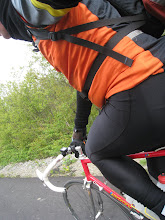What is... Active Transportation?
Active transportation is FUN!
Actually, Let's have the Public Health Agency of Canada define it for us:
What is Active Transportation?
Active transportation is any form of human-powered transportation. It is any trip made for the purposes of getting yourself, or others, to a particular destination - to work, to school, to the store or to visit friends. As long as it is "active", you can choose the mode - walking, cycling, wheeling, in-line skating, skateboarding, ice skating (eg. on a canal). Walking and cycling are the most popular forms of active transportation. It can also involve combining modes such as walking/cycling with public transit.
Active Transportation is important for a number of reasons! (not just because it's fun!)
(snip)
The most energy efficient and least costly mode of transportation is muscle power!
For distances up to 5 km, cycling is recognized as the fastest of all modes from door to door.
Taking Action
Here are some ideas that may help you consider adopting more active modes of transportation:
- Think twice about using your car for every trip. Could you walk or use your bike to visit friends?
- Dust off your bicycle and cycle to work when the weather permits.
- Trade in your dress shoes for running shoes, strap on a backpack and walk all, or part of the way to work/school.
- Instead of driving your kids to the park, why not make it a family outing on your bikes.
- If you are considering moving, think about the transportation options available to you in the new locations you are considering. How far will the distance be to those places you regularly need to get to. Could you walk to do most of your small errands? How far away is the nearest school for your child? Is this new neighbourhood "pedestrian friendly"?
But keep in mind, it's not just up to an individual to adopt active transportation, our communities, workplaces and schools must also support active transportation.
Communities that endorse active transportation :
- have dedicated bicycle lanes and routes;
- advocate for sharing the road with cyclists;
- undertake specific measures to ensure the safe integration of pedestrians, cyclists and other active users among motorized vehicle traffic;
- regularly maintain and upgrade pedestrian and cycling facilities;
- provide storage for bicycles throughout the city;
- have an integrated network of pedestrian and cycling paths that are designed for efficient transportation as well as recreation;
- favour urban design that reduces the distances that people have to travel to get to work, retail areas, schools and recreational/leisure pursuits;
- encourage the retail and service sectors to support customers who use active modes of transportation;
- plan streetscapes to be visually pleasing and inviting to pedestrians;
- have a network of greenspaces throughout the urban and suburban areas;
- make access to public transit easily integrated with pedestrian and cycling facilities to encourage intermodal travel;
- encourage driver education about how to share the road with multi-users;
- encourage feedback from citizens, pedestrian and cycling advocacy groups.
Workplaces that endorse active transportation:
- support and encourage their employees to adopt active transportation;
- provide secure bicycle storage, lockers and shower facilities for employees;
- allow more flexible dress codes;
- organize workplace challenges, employee recognition programs or support community events to increase awareness;
- work with municipal planners to map out safe and efficient routes to work and to address infrastructure or safety problems;
- emphasize reduced motorized transportation while at work and encourage more active modes;
- provide or subsidize safe cycling or in-line skating clinics for their employees.
Schools that endorse active transportation:
- support and encourage their students to adopt an active way to get to school;
- work with the municipality to identify safe routes for children while addressing safety and infrastructure barriers;
- encourage parents to form "escorted walks" to and from school for young neighbourhood children;
- have teachers work with children to identify the safest routes to get to school while teaching children about traffic and pedestrian safety;
- offer cycling and in-line skating skill and safety courses;
- work with parents, motorists and the community at large, to make the trip to school a safe trip for children and youth.
For lot's more information, please visit the Public Health Agency of Canada.


0 Comments:
Post a Comment
<< Home